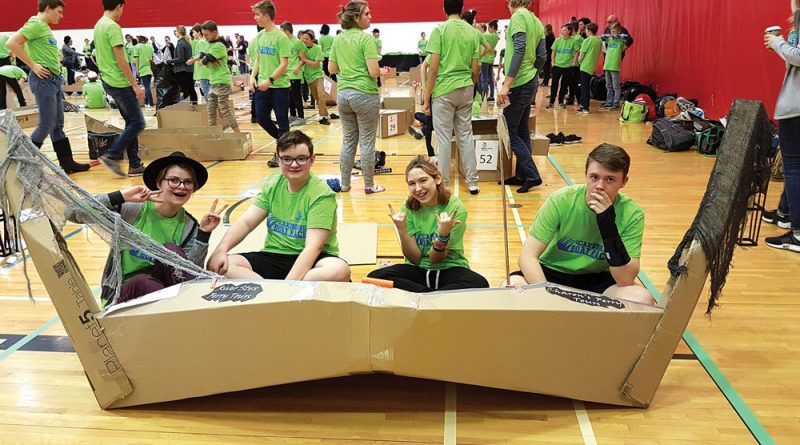Origami boat doesn’t float
By Adelle Ellis, Times Reporter


Photo Courtesy of Ed Eberts
The Strathmore High School (SHS) cardboard boat race team made a big splash at the Skills Canada Alberta Southern Cardboard Boat Race at the Southern Alberta Institute of Technology (SAIT) on Nov. 21.
Unfortunately, the team’s enthusiasm as they hopped into the vessel caused the cardboard boat to buckle and rapidly sink. But they did walk away from the skills competition with the Float your Boat award for the best design.
“We didn’t win the race but we actually got the award for the best design … so that was amazing even though we didn’t win the race,” said Ed Eberts, cardboard boat mentor and technology teacher at SHS.
In SHS’s first year in the competition it garnered the interest of four students, just enough for one team. Josh Kennedy, Cody Holdaway, Mason Burns and Meadow Tribe met every week in October and November to research boats, and design and buoyancy, before constructing three practice boats that never got the chance to see the water.
Participants were given an hour-and-a-half to construct a boat out of four pieces of four foot by four foot cardboard, one roll of packing tape, one roll of duct tape and a cutting tool. Teams could also supply their own measuring instruments and pencils to aid in the building process.
Where most other boats were described as “cardboard coffins,” a normal box with a pointy end, SHS’s boat was made to resemble origami, completely folded with no cuts. The design should have given the team an edge as the boat theoretically should have had less weak points.
“Unfortunately, during the race the teenage brain kicked in and they rushed a little bit; the boat buckled and so it was taking on water fast,” said Eberts, who added that the remaining prototypes will be tested in the town pool.
The team is already making plans for the competition next year.
“They’ve (learned) teamwork (and) I was happy to see these kids work together very well. But the thing they learned most was measurement and geometry in a practical sense but also design, building a prototype and then iterating, redesigning if something goes wrong. It’s an exercise in design thinking, teamwork and skills like practical measurement,” said Eberts.
